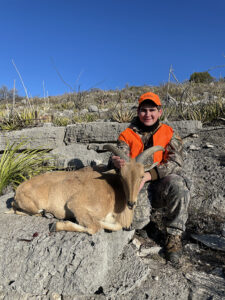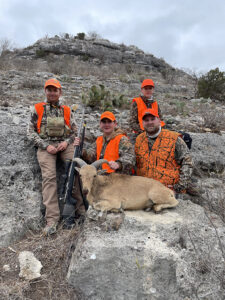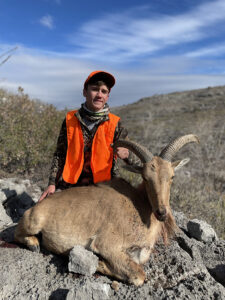An Invasive Exotic, Added Bonus, or Both?
by Austin Stolte, TYHP Huntmaster, TPWD Wildlife Biologist, Val Verde County

The sheep already had us pegged. If you hunt aoudad, you know it can be a challenge to slip into a herd unnoticed. Aiden and Gunner picked out the three rams along the lechuguilla covered hillside (a plant they would learn to avoid very soon). The young men made a quick jaunt behind some junipers so we could get out of sight from the sheep and get fifty yards closer. They deployed their bipods and rolled out from behind the juniper into a prone position. The previous day the hunters spent some time behind their rifles practicing extended range shooting from field positions. Aiden was up first. We ranged the sheep at just over 300 yards. Aiden quickly dialed his optic to compensate for bullet drop; there was no wind to worry about. His brain told his nerves to calm down and went through the motions he needed to perform: get prone, get settled, load a round, sight picture, safety off, deep breath, exhale, respiratory pause, trigger press…

It would be safe to assume that most hunters not only care about the game they pursue but also the land, habitat, and wild places these animals call home. In fact, most conservation dollars used to manage the land these animals call home can be traced back to hunters, sports shooters, outdoor enthusiasts, anglers, private landowners, and various NGO conservation groups. Those conservation dollars along with a change in land and wildlife management ethic in the mid to late 20th century have done wonders for many of our game species. This management system has worked so well in North America that many species that were once on the brink of disappearing are now thriving today. It has worked so well in fact that many wildlife biologists would agree that some species are above carrying capacity or in other terms, overabundant on a given landscape. Texas is well known for its robust population of native game such as the white-tailed deer, javelina, mule deer, Rio Grande turkey and so on, but it is equally known for its robust population of exotic animals as well.
One exotic that has done exceptionally well in Texas is the Barbary Sheep also known as the Aoudad. They were first brought to Texas in the 1950’s and have flourished in the arid and semi-arid rugged environments of the Edwards Plateau, Trans-Pecos, and Panhandle regions of the state. Wildlife researchers are just beginning to look at the impacts these introduced sheep are having on the landscape. Early data suggests there is certainly competition going on between these sheep and native wildlife. In my career as a wildlife biologist, I have seen firsthand the damage overabundant aoudad populations can have on both plants and soil.

Due to the terrain these aoudad call home, the style of hunting required to pursue them, and the large horns (both males and females have horns, but rams can easily grow in excess of 30+ inches in length) they possess, it has made them a highly sought-after species to hunt. Costs to hunt these large rams can vary, but can go for as much as $7,000.00 for a multi-day guided hunt. Here in comes the conundrum…we have some scientific evidence as well as a wealth of anecdotal observations that aoudad damage some of the habitats they live in. However, aoudad undeniably have both recreational and financial value. There are many cases in which these sheep have increased the income of private ranches which in turn those dollars are put back into the ranch in the form of wildlife and habitat management. Regardless, if you are pro-aoudad, anti-aoudad or somewhere in between, at this point one thing is for certain, aoudad are here to stay in the Lone Star State. With that in mind, we must be mindful of their inherent values, while in turn, do our part to manage them to reduce habitat degradation and impacts to our native wildlife species.
Aiden’s rifle erupted, sending a perfectly placed shot right through the ram’s shoulder. He expired within seconds. At that point chaos broke loose, the remaining rams scattered but stopped at about 325 yards. Gunner calmed his nerves, pressed off his shot, and another ram was down. Our group of four hunters would end up harvesting twelve sheep that week and go home with an everlasting memory, understanding of wildlife management, and coolers full of meat to feed their friends and families. A huge thanks goes out to the private landowner, Texas Youth Hunting Program, and all the volunteers who made this hunt possible.